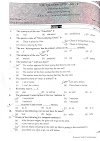The property of magnet to attract another magnet and magnetic materials is termed as magnetism.
A magnet has directive property, i.e if a magnet is freely suspended it will come to rest in a position close to north-south direction.
Pole : Pole of magnet is where attracting power of magnet is maximum. Pole strength is vector quantity.
The force of attraction or repulsion between two magnetic poles of strength and separated by distance is directly proportional to the product of pole strengths and inversely proportional to the square of distance between their centers.
where is magnetic force constant.
Repulsion is a sure test of magnetism.
On heating magnets, molecular magnets acquire some kinetic energy. Some of the molecules may get back to the close chain arrangement, so magnetism of specimens would reduce heating.
S.I unit of magnetic field strength is tesla. unit is gauss.
A line perpendicular to the magnetic length which bisects it is called its magnetic equator.
Uniform magnetic field is a point at which magnetic field intensity is the same at all the points.
The imaginary line joining the magnetic north and south poles of the earth’s magnet or any magnet is called its magnetic axis.
The imaginary line joining the geographical north and south poles of the earth is called the geographical axis.
The angle between the geographical meridian and the magnetic meridian is called declination.
Angle made by a freely suspended magnet with a horizontal component of the earth magnetic field at a place is called angle of dip.
The angle of dip in magnetic meridian is called real dip or true dip and the angle of dip at other planes is called apparent dips.
A magnetic device used to measure the angle of dip is called dip circle.
:
If the pole and pole of a magnet are separated by a very small distance then it is called a magnetic dipole.
Magnetic dipole moment
Direction of magnetic dipole moment is from south to north.
Two magnets are inclined at an angle then,
Above case is condition when two likes pole together, if incase of two unlike pole together replace with .
: :
The direction of is along , for short bar magnet
The direction of is along , for short bar magnet ()
.
Torque is minimum for degree and maximum for degree.
:
where is the angle between and .
For stable equilibrium angle between them must zero and for unstable equilibrium angle between them is degree.
Work done in displacing dipole from to is
Work done in rotating dipole from equilibrium position () through angle is
Magnetic material
:
:Field in which material is placed for magnetization .
When a magnetic material is placed in the magnetization field produces a dipole moment per unit volume is known as I .
: The ease at which magnet can be magnetized.
Materials
:
Poor magnetization in the opposite direction when placed in the magnetic field.
:
Poor magnetization in the same direction when placed in an external magnetic field.
:
Strong magnetization in the same direction when placed in a magnetic field.
.
Lagging of B behind H is called hysteresis.
Coercivity is a measure of the magnetising field required to destroy the residual magnetism of a specimen.
Retentivity of a specimen is a measure of magnetic field remaining in the specimen when magnetizing field is removed.
Steel is used in permanent magnet(High Coercivity and Low retentivity).
:
I=Moment of inertia ,M=Magnetic moment of magnet,
H=Horizontal component of earth mag field.
I=moment of inertia
:
:
:
Read and Digest
Magnetic field doesn’t interact with charge at rest.
Magnetism is caused by both spin motion and orbital motion of electrons but majoris spin motion.
Pole strength is independent of length but depends on the cross sectional area of the bar magnet.
At neutral points , so and
Magnetic moment of noble gases
is the universal property of all substances.
Ferromagnetic becomes para magnets.
If a magnetized wire having dipole moment M is bent at an angle α then dipole moment of arc is
If a bar magnet is cut into two equal parts:
:
Pole strength remains the same, magnetic dipole moment(M) becomes half.
:
Pole strength becomes half and dipole moment also becomes half.









0 Comments